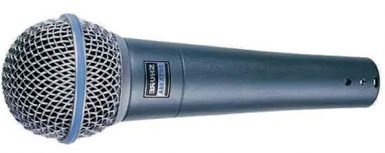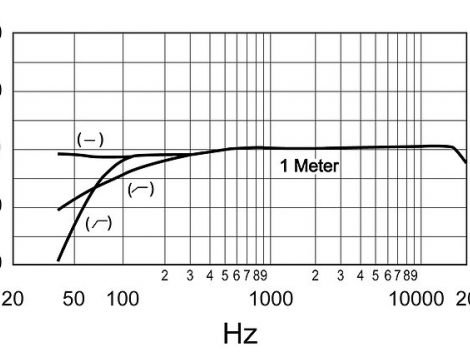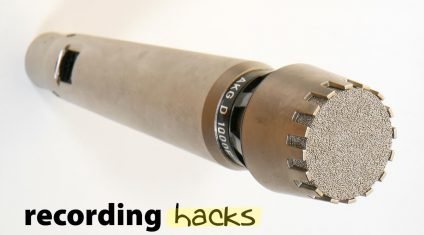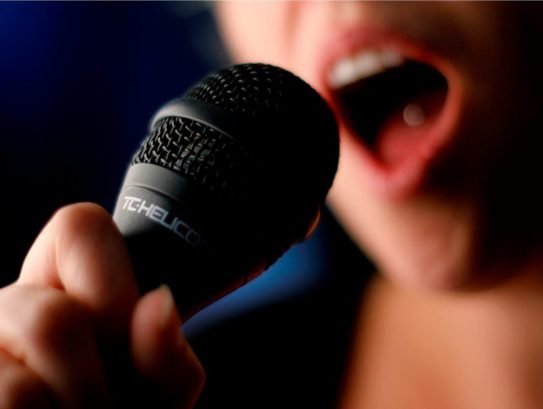
Microphones
These are the primary tools for picking up sounds from vocalists, instruments and groups.
Knowing how they work, how to use them. and how to mix them
are key skills for an audio technician or engineer.
If you are new to audio technology and microphones, you may want to start here.
Microphones are classified by the mechanism used to pick up sound pressure waves. The primary types are these:
Dynamic -
In this type (moving coil), the sound waves strike a diaphragm that produces an electrical signal using a coil that moves in a magnetic field. This produces a signal in the microvolt range that is sent to an external preamplifier. This is the most commonly used type, and years of development have resulted in very robust designs with excellent frequency response. However, due to the nature of this structure, all tend to have some type of high-frequency resonance that shows up in the response curve.

Condenser -
In this type, the movement of a thin, electrically charged diaphragm, creates a small varying voltage that is then amplified internally and sent to an external preamplifier. A common type, an Electret, has a permanently polarized capacitor element. Both types require phantom power to drive the electronics inside the microphone needed to amplify the signal from the condenser element. For this reason, condenser mics tend to have a higher self noise than dynamic mics and are somewhat more fragile. These mics tend to have great sensitivity with a wide and smooth frequency response.
Go here for an excellent video on dynamic and condenser mics as transducers. MXL also has a good page on condenser mics,

Ribbon -
In this type of dynamic microphone, a thin metal ribbon moves in a magnetic field to produce the electrical signal. This design results in a diaphragm that is very light and thus more responsive than the moving coil design, but it also produces less output, requiring a transformer to step up the voltage. This design generally has less output than a moving-coil dynamic mic, and it also has a natural figure-eight directionality. A ribbon mic has a very uniform frequency response across the front of the mic and a nearly identical response across the back. As the sound level decreases when you get off-axis, it still sounds like the original source. And the sound pickup from the sides of the mic (90 degrees off-axis) is completely nonexistent. You can't use them everywhere, but where you can, they give good results. Sweetwater has an excellent article on Ribbon Mics.
Guitar Pickups -
A standard microphone can be used for recording the sound from a guitar and for live sound in many situations. An electric guitar, whether a true electric or an acoustic guitar fitted with a pickup, requires a device to convert the string motions into an electronic signal. The pickup device is not a microphone, as discussed here, but is mentioned for completeness. See the Ehome Recording Studio and the Guitar World sites for more details. Sweetwater also has a good page - How do Pickups Work?


While there are other types of microphones, they are seldom used for audio performance purposes. Select the More Information tab to learn about other types of microphones.
Microphones are also classified by the directional nature of their pickup pattern. There are 4 basic types:
Omnidirectional - This type picks up sounds from all directions.
Cardioid - This type picks up sound in one direction primarily - the front - and less sound from the rear.
Hyper-Cardioid - This is a slightly more directional version of a cardioid microphone.
Bi-directional - This type picks up sound primarily from the front and rear and significantly less from the sides.

The above diagram show four different idealized polar patterns..
Since they are symmetrical about the vertical axis, the angles are measured
left and right from zero to 180 degrees
Click here for a more detailed explanation of these diagrams.
A number of microphones, both handheld and studio types, can be switched among several directivity patters, providing more options for their use in different situations. Examples include the Shure KSM9 series, the AKG C414, The SE T2, and the Blue Yeti Pro.
IsaacsMusic has an excellent article on mic polar patterns with a video/audio demonstration of the C414.
Every microphone is manufactured to have a combination of features that match the goals set by the designer. Certain characteristics are a natural consequence of the transducer type, while others are meant to enhance the microphone's ability to perform in various situations. For example, a vocal mic used on stage needs to be fairly rugged, while one designed for studio recording can be less so. This causes dynamic mics to be used more frequently on stage applications than condensers, since the latter have a transducer and electronics inside that require a power source and may not take rough handling as well as the former. Ribbon mics are even more fragile, and they have a somewhat limited high-frequency response, so their applications are fairly specialized.
One thing that is important to hand-held microphones is handling and cable noise. A well-designed mic such as the Shure SM58 has a very effective shock mount that protects the capsule and virtually eliminates handling noise. This property is one that separates well-made mics from cheap knock-offs.
A vocal mic can have a more limited and perhaps "sculpted" frequency response curve, while one designed for picking up instruments and acoustical testing needs to have a smoother and wider frequency response. In fact, such mics are usually called "instrumental" mics and are usually condensers. An omni-directional mic is a pure pressure-sensitive transducer and tends to have a flatter response than a directional mic. The design of a directional microphone tends to result in what is called the "proximity effect." This phenomenon causes the low frequencies below about 200 Hz to be increased relative to the higher frequencies. This is because sound from the around the mic is directed to the back of the transducer in a manner that reduces the response from the rear - a pressure-gradient transducer. See below for more information on the proximity effect. As the source gets within a few inches of the directional mic, there is not only an increase in volume, but also an increase in bass response. The diagram to the right show the response curve of the Shure Beta58a microphone. This is one of the only mics for which Shure publishes the proximity effect curves. The chart shows that at 200 Hz the response is about 15 dB greater at 1/8 inch than at 2 feet. The Shure SM58 would be expected to behave similarly. At 1/8 inch, the source is still about 0.75 inch away from the capsule. One bass singer I knew insisted on using his own mic at performances, one where he had indented the wire mesh screen so he could get closer to the capsule. He also used a foam pop filter so that this was possible with minimal plosives.
Shure has an excellent page on Proximity Effect. An interesting video that compares the Shure Beta58A and the SM58 was published in June 2021 by Jon Anderhub. He provides an excellent demonstration of the proximity effect. Note the problem with plosives for both of these mics.
When miking instruments, it is usually desirable to use a mic with a fairly wide and smooth frequency response. A good example is the Shure SM81 small diaphragm condenser mic. This one is widely used with drums and acoustic guitars. It has a very flat response with extended bass and a switch that has two positions for reduction of the bass, to help compensate for its proximity effect. A similar, significantly less expensive, mic is the Shure PGA81. This one can be used with a AA battery or phantom power. Its response curve is similar to the moderate bass reduction curve of the SM81. Its sensitivity is about 3 dB lower and it maximum SPL about 6 dB lower than the SM81, but it is a very useful and well-built mic. Two other excellent small diaphragm condenser (SDC) mics are the Samson C02 and the Behringer C-2 or B-5. Their small size, directivity, and sensitivity make these excellent choices for recording instruments and groups of people. Audix recently introduced its $2000 A127 omnidirectional metal film condenser microphone. Aimed at professional recording applications, this is an excellent SDC mic. Audix demonstrates its performance with an A-B stereo pair recording of a string quartet. Listen to it with good headphones,
In the studio, the most commonly used type of microphone is the large diaphragm condenser, whose capsules measure about an inch or more in diameter. These typically have a wide frequency response and good sensitivity. They are preferably used with a pop screen for vocals . There is a wide range of models, with prices from about $100 to over $5000. See the Applications and More Information tabs for further details.
In 2016, Shure introduced a new microphone design that seeks to minimize the proximity effect yet maintain a cardioid directionality. Called the "Dualdyne," this design uses two diaphragms in a special arrangement that helps minimize the proximity effect but retains the directionality of the mic. This was not the first mic to use two separate capsules, but Shure added some refinements to its design to improve its overall performance and reduce the proximity effect. Shure has an excellent video that shows the development of the KSM8 Dualdyne Microphone. Mitch Gallagher has an excellent video describing this microphone. Unfortunately, he does not use a pop filter, so as he gets close to the mic you'll hear plosives that interfere somewhat with perception of the slight proximity effect of this excellent $500 mic.
The AKG D202 and later D222 was probably the first commercial microphone to use dual diaphragms to minimize the proximity effect of a cardioid mic. The mic had a very effective sintered bronze pop filter, exclusive to AKG, that also protected the capsule from dust and spittle. I believe it was first produced in the late 1960's. Coutant.org has an excellent page describing this vintage microphone. AKG discontinued this mic around 1980, but there was such demand for its performance that they added it back to their catalog, at least for a time, but it is no longer available from AKG, now part of JBL. Some are available from sources such as Ebay.
Another vintage mic that had the AKG sintered bronze pop filter was the D1000E. Numerous versions of the mic were sold, dating as far back as 1967. I actually used some of these in the 70's. It was a good-sounding mic with a moderate proximity effect and three frequency response settings. Recording Hacks has some information about the mic. It can still be found on sites like Reverb.com or Ebay.
Microphones are used in any application where it is necessary to amplify or record a sound source. Any type of microphone can be used in most cases, but in general, a microphone is selected based on the nature of the sound source and the characteristics of a particular microphone. This picture to the right is the microphone array inside an Alexa Echo. It consists of 7 small condenser microphones (MEMS) in a circular beam-forming array that uses Amazon’s proprietary software for wake word recognition, beam-forming, noise reduction, and echo cancellation.
For a given application, there are general preferences or recommendations that may apply, but there are exceptions to almost every rule one might employ. That is why it is so important to understand the various types and characteristics of microphones. Generally, applications fall into these categories:

Vocals -This tends to be a situation fraught with personal preferences, from the viewpoint of both the performers and the audio techs. The audio tech may strive for an accurate frequency response and use pop filters to minimize plosives, while the performer wants a mic that gives them the type of sound they prefer, one that emphasizes the good part of their voice and helps correct whatever deficiencies might exist. Some examples: A baritone tends to prefer a microphone that has appreciable proximity effect, because it adds low-frequency richness to his voice. This usually means a dynamic mic that is used close to the mouth, and they may not object to the use of a foam pop filter to minimize plosives. A tenor, or a female, tends to prefer a mic that has more high-frequency content, so they tend to object to a pop filter, either because they feel it reduces the high frequency harmonics of their voice, or, for a female, it hides too much of their face.
Many amateur vocalists and audio techs think a mic should always be used as close to their lips as possible, because that's what they generally see professional performers do. They fail to understand that in most situations, these performers are in a very loud environment, and many have fairly weak voices, so it is important that they get as much volume from their mic as possible. Moreover, these same professionals may prefer a particular microphone that has a low output level and they may object to pop filters. Because of the high sound levels generally used, the various plosive and mouth noises, that result are buried in the noise. There is usually a professional engineer manning the mixer who can apply compression and make other adjustments needed to compensate for the environment.
In other environments, such as a church, the ambiance is quite different, and miking techniques should be used that give a more natural sound. This calls for the use of pop filters to minimize plosives, a varying of mic distance to help correct for vocal differences across the frequency range, and lower overall sound levels to emphasize communication and worship. See the video to the right Tips for Singing Into a Microphone for more details.
In a recording studio, pop filters are generally used to avoid plosives, and the vocalist is some distance away, unless the proximity effect is desired.
Distance is a critical factor in using microphones. Not only is the proximity effect a consideration, but the sound pressure level (SPL) at the microphone goes as the inverse square of the distance to the source. This means that if the distance is cut in half, the SPL goes up four times. Thus, a bass vocalist can increase his output substantially by getting the mic as close as possible to his mouth, boosting both the bass content (proximity effect) and the level substantially (distance factor).
When a vocalist reaches a point where their vocal level is low -typically in the lower registers - bringing the mic closer to the mouth will help keep the volume up. When a vocalist reaches the most powerful output range, he/she can move the mic away somewhat to keep the volume more even. This means that the singer must keep the microphone at a suitable distance away from the mouth most of the time so that the distance can be varied as needed. "A singer can get a deep, earthy sound by singing very close, then change to a more penetrating sound by singing louder while moving the microphone away. This kind of creative use takes some practice, but is very effective. " (Audio Technica web site)
Despite what many people say, a mic generally should NOT be kept as close to the mouth as possible, unless the situation calls for this. However, since distance is such a critical factor, it's important that a speaker or singer learn how to maintain a consistent spacing and change it only as needed to compensate for vocal intensity. The female singer to the right is using a pop filter and holding the mic above her mouth. Both techniques help to minimize plosives and sibilance.

Public Speaking - Microphone selection and placement are important for public speaking. Generally, a directional mic is used to minimize pickup of environmental sounds behind the mic A foam pop filter should be used to minimize wind noise and plosives. Two special types that are often used are the Lapel and the Head-worn types. A lapel is somewhat simpler to use, but it requires that the mic be six or more inches from the mouth. This is fine when the environment is fairly quiet, such as in a studio or worship service. An omnidirectional type is less sensitive to position, but a cardioid pattern helps reduce environmental pickup.
Another type that has become quite popular in recent years is the Headworn microphone, These may be a true head-worn style that clips over both ears, but can be an ear-worn style that clips over one ear. These are available as omnidirectional and cardioid types. The primary advantage is that it enables the mic element to be placed closer to the mouth. It is important that the mic not be directly in front of the mouth, as these are very sensitive to plosives. The mic element should be to the side of the mouth. In theatrical productions, it is sometimes helpful to place the mic element at the performer's hairline, either at the ear or the forehead, if it is a lapel type.


Instruments - To some extent, the particular type of instrument is a consideration. In general, condensers are preferred because of their sensitivity, their relatively smooth and wide frequency response. This is particularly true for drums, strings and horns in the mid to high frequency ranges. Condensers are great for picking up the high frequencies and transients drums generate, but their sensitivity can result in signal bleed from other sound sources nearby. Heil, as an example, has developed a dynamic mic, the PR 30, that is very effective with drums. For bass instruments, dynamic mics are often used, placed close to the sound source. For example, the Shure SM57 is a standard for miking guitar amp speakers, and dynamics are often used for kick drums. TheSM57 can take high sound pressure levels, it's proximity effect adds to the bass level, and the mic screen design allows the capsule to be very close to the device.. For a string bass, a condenser usually works better than a dynamic, as it can be used a bit farther away, thus picking up more of the overall character of the instrument.
A lot depends on the environment. In a studio, you can place the mic anywhere you want. In a live situation, it depends on how loud the sounds are around the guitar or amp. Closer placement with the mic will decrease pickup of other sounds but with a directional mic will also increase the bass frequencies. Select the More Information tab for additional information about miking instruments.

A special clamp allows use of a Royer ribbon mic and a Shure SM57 close to each other. This combo will be placed in front of the amplifier in a position selected to give the type of sound preferred - brighter vs more bass. Be sure that the mic does not contact the speaker itself or the grill cloth.
Distant Pickup -
This applies to large vocal groups or perhaps the distant sound of a band or performance, as well as to podium or conference table miking. For this type of application, a condenser microphone is the first choice, and generally a more directional mic is preferred. Sound pressure levels are much lower in most distant applications, and a condenser is more sensitive than the other mic types. When picking up a group, the microphones should be placed so as to minimize the difference in distance among the singers, and multiple mics should observe the rule that the mics should be three feet apart for each foot of distance to the source to minimize phase interference, When it isn't possible or practical to hang a mic, there are several long-boom mics than can be used.
DPA has an excellent guide for miking groups.
Hypercardioid and supercardioid mics are somewhat more directional than cardioid mics and should be considered when miking from a distance. For longer distances, and when ambient sounds are present that need to be minimized, a highly-directional, shot-gun type is called for, and in some cases a mic can be used with a parabolic reflector to help focus sound on the capsule.

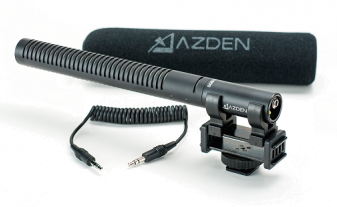

Special Purpose -
There are some situations for which a particular type of mic has been designed or is called for. One such type is the boundary mic. This is usually a condenser mic placed on a surface which helps direct more sound to the mic element. Situations such as a podium, a conference table, or a theatrical production might call for such a mic, and most of the major mic manufacturers make them. In some situations, a dynamic mic can be placed near a surface to use this effect. A good 2021 overview of boundary mics and automixers can be found at SVCOnline.com.
For stereo sound, at least two mics are needed. They can be spaced apart 3 feet or more, depending on the situation, or directional mics can be placed in a Blumlein alignment where they are perpendicular to each other. Also called ax XY arrangements, this type of mic is available for small digital recorders, as as shown to the right .
Another type of mic that is becoming popular is the microphone array. These are used in conference rooms or area monitoring situations, and a popular home automation device, the Amazon Echo, uses this technique with 7 microphones. For examples, check out some Shure Arrays and the Acoustic Magic Voice Tracker.
A most unusual application is the DPA microphone that is now on the surface of Mars.

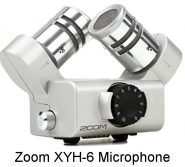
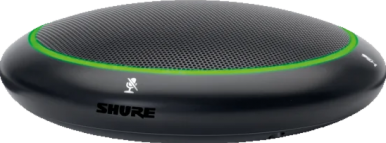
The Shure MXA310 Array Microphone
Shure offers the following basic rules for using microphones. These are general guidelines - the guidance given above should be considered in applying these general rules.
General Rules for Use
- Aim the microphone toward the desired sound source (such as the talker, singer, or instrument) and away from unwanted sources.
- Place the microphone as close as practical to the desired sound source.
- Work close to the microphone for extra bass response.
- Use only one microphone to pick up a single sound source.
- Use the fewest number of microphones as practical.
- Keep the distance between microphones at least three times the distance from each microphone to its source.
- Place microphones as far as possible from reflective surfaces.
- Add a windscreen when using the microphone outdoors.
- Avoid excessive handling to minimize pickup of mechanical noise and vibration.
- Do not cover any part of the microphone grille with your hand, as this will adversely affect microphone performance.
Sweetwater has an excellent article where a good vocalist gives guidance for use of a microphone. He has some great suggestions. Unfortunately, his presentation is marred by plosives because he uses an SM58 without a pop filter. A perfect demonstration as to why a pop filter is so important for vocalists.
How NOT to use a microphone

Ales Stephanic published an article in 2022 that suggests ways in which a vocalist can help their sound engineer by following some simple suggestions, such as not cupping a directional mic.
- Arthur Fox at MyNewMicrophone.com has an excellent article that discusses the differences in Microphone Characteristics.
- Joe Albano published in 2019 an excellent article on Choosing The Right Microphone For Your Studio: Mic Types.
- StringJoy has a good article on Recording Acoustic Guitar that covers microphone types and placement schemes.
- Alexander Briones{2015) wrote an excellent article on The Different Types of Mic and their Uses.
- Sweetwater published in December 2022 an article on Choosing Between Headset and Handheld Microphones for vocal performance. This describes the various performance considerations involved and provides examples of available devices.
- In 2023 Sweetwater published the Best Condenser Mics under $1000. This gives some details about 13 excellent condensers, with links to information on other microphones.
- In Microphone Approaches For Acoustic Performances Bruce Bartlett (June 2023} suggests ways to mic various instruments. He previously published Capturing The Moment: Microphone Techniques For Live Recording (2021) where he offers suggestions for using mics during live performances and gives several helpful tips for instruments and vocals.
- Sweetwater has a page that demonstrates 50 different vocal mics. You can listen to male and female vocals with each mic.
- Mitch Gallagher has an excellent video on the Shure SM58, describing its characteristics and use in various applications. In another video, he compares the SM58 with the Beta58a. I think his statement that the Beta58a has less proximity effect than the SM58 is incorrect. Since it is more directional, I suspect that it has more of a proximity effect. It does have less low-frequency response than the SM58. Notice the plosives that occur with both mics as he speaks. That is why I always try to use mics like this with foam pop filters. I would say that the primary differences between the two is that the Beta58a has a supercardioid polar pattern, has some 4 dB more output, and is significantly more expensive. Shure has a page called 58 Reasons to Love the SM58 - part technical, part humorous. One statement says "It just sounds natural." I disagree. With a strong proximity effect and a high-frequency resonance peak, this mic definitely is not natural-sounding.
- Another good video on the SM58 and its proximity effect Shure’s Chad Wiggins explains that this is perfectly normal – and how a savvy singer can use it creatively
- DPA has an excellent article on the effect of hand position when using a hand-held microphone, Both pictures and audio clips demonstrate these effects.
- A video comparing the SM58, the Beta58a, and the Beta87a is here. Notice the plosives that occur with all three mics and the somewhat thinner low end of the 87a. Podcastage has a good review that shows some advantages and disadvantages of the 87a - significant plosives, high self-noise and limited low frequency response, but perhaps a great mic for female vocalists. Another good video is here.
- Recording Hacks published in 2011 a good review of 10 mics that might be used for podcasting, but the information is helpful in any situation where these mics might be used,
- Shure has an excellent article on its MXA910 Array Microphone that discusses important topics such as polar pattern and EQ, automatic mixing, acoustic gain calculations, and room environment.
- Nicholas Radina published an article in December 2021 that describes an example of Orchestral Sound Reinforcement. He provides a diagram and description of the performance layout and discusses the mic selection criteria he used. This is the first of a series of articles.
- The Wikipedia entry on Microphone has good information on the various types of microphones and the history of their development.
- The Heil website has an excellent tutorial on microphones. Highly recommended.
- The AKG web site has a good series of articles on Microphone Basics.
- Shure has an extensive article on most aspects of microphone use.
- Sweetwater has an excellent Studio Microphone Buying Guide as well as an excellent video on mic placement with an electric guitar.
- Learn about a microphone that is now on Mars!
- A good place to start for information on Microphone Arrays is the Wikipedia entry.
- Go Here for a more technical presentation regarding arrays.
Below is a great video demonstrating the Low-Frequency Proximity Effect. Be sure to listen with good headphones or speakers , not a phone or tablet speakers. Note the plosives when the SM58 is used without a pop filter. He also uses the SM141 but with a pop filter. This is a detailed description of what causes the proximity effect with directional microphones. (Source):



